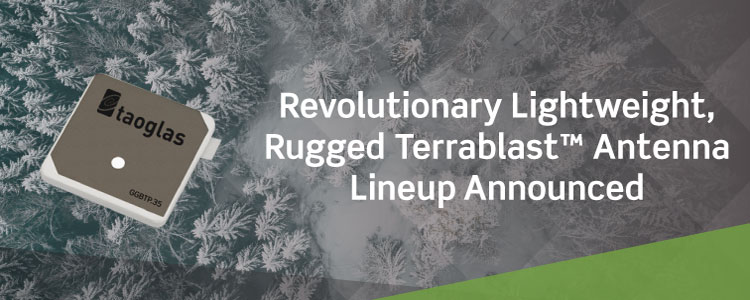Taoglas at Mobile World Congress 2018 introduced its patent-pending TerrablastÔ range of antennas, a revolutionary, polymer-based series of patch antennas that are 30 percent lighter than their ceramic counterparts and extremely resistant to fracture upon impact. The combination makes Terrablast a perfect fit for the automotive and unmanned aerial vehicle (UAV) markets, where impacts are possible, but antenna performance cannot be compromised.
Unlike traditional patch antennas, which are ceramic, Terrablast uses a new class of Taoglas polymer dielectric material composed of glass-reinforced epoxy laminate. The addition of the polymer to the blend makes the antenna extremely lightweight, yet impact resistant. The Terrablast antennas are designed to withstand drops, falls and impacts, making them ideal for applications such as UAVs, where the antenna’s mechanical robustness following potential impact is critical.
The Terrablast patch antennas are also typically 30-35 percent lighter than traditional patches. In drone applications, where weight over battery life is critical, each gram reduced enhances battery life.
“Taoglas is leading the charge in material science advancement for the antenna industry, and our new Terrablast antennas are the latest innovation we’re introducing to the market,” said Ronan Quinlan, co-CEO and co-founder of Taoglas. “A variety of industries and applications, especially the automotive and drone markets, will benefit from Terrablast’s high-performance capabilities in a lightweight, impact-resistant form factor.”
The first antennas in the Terrablast range are a 25 mm embedded 2.4 GHz patch antenna and a 35mm embedded GPS patch antenna. The circular polarized design of the 2.4GHz patch ensures maximum performance for constantly moving mobile applications where the orientation to the transmitter or receiver frequently changes. The antenna weighs just 5.6g compared to an equivalent ceramic patch of 8.5g, making it an ideal weight-saving substitute for ceramic patches in UAV applications.
The 35mm GPS/GLONASS/BeiDou patch antenna has extremely high efficiency of over 70 percent across all bands, improving time to first fix (TTFX). At just 10g, the 3.5mm-thick patch is 5.5g lighter than typical ceramic GNSS patches.
All Terrablast antennas undergo rigorous temperature, vibration and impact tests, exceed the highest ISO 16750 standards, and are manufactured in Taoglas’ purpose-built facilities in Taiwan and the United States.

Filed Under: Aerospace + defense




